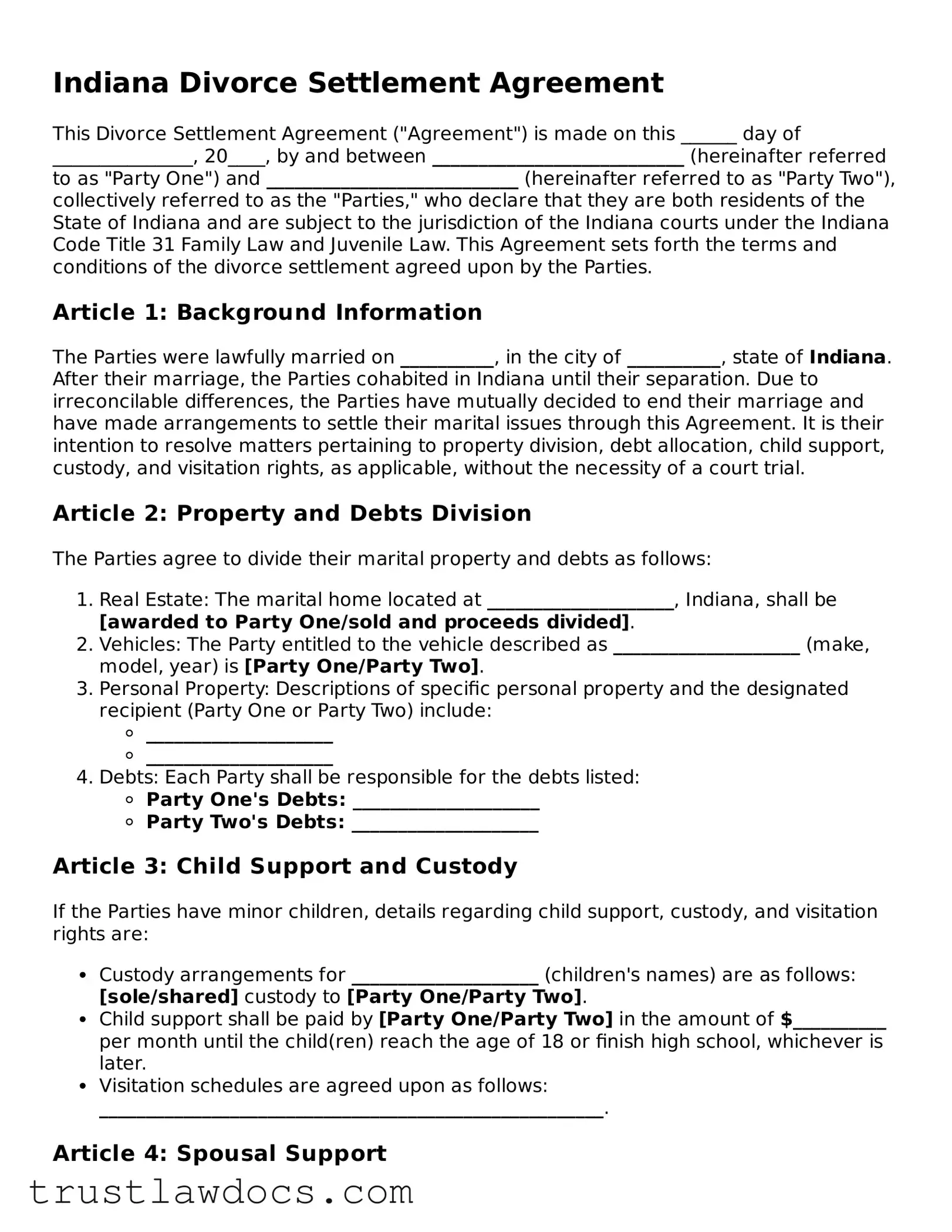Indiana Divorce Settlement Agreement
This Divorce Settlement Agreement ("Agreement") is made on this ______ day of _______________, 20____, by and between ___________________________ (hereinafter referred to as "Party One") and ___________________________ (hereinafter referred to as "Party Two"), collectively referred to as the "Parties," who declare that they are both residents of the State of Indiana and are subject to the jurisdiction of the Indiana courts under the Indiana Code Title 31 Family Law and Juvenile Law. This Agreement sets forth the terms and conditions of the divorce settlement agreed upon by the Parties.
Article 1: Background Information
The Parties were lawfully married on __________, in the city of __________, state of Indiana. After their marriage, the Parties cohabited in Indiana until their separation. Due to irreconcilable differences, the Parties have mutually decided to end their marriage and have made arrangements to settle their marital issues through this Agreement. It is their intention to resolve matters pertaining to property division, debt allocation, child support, custody, and visitation rights, as applicable, without the necessity of a court trial.
Article 2: Property and Debts Division
The Parties agree to divide their marital property and debts as follows:
- Real Estate: The marital home located at ____________________, Indiana, shall be [awarded to Party One/sold and proceeds divided].
- Vehicles: The Party entitled to the vehicle described as ____________________ (make, model, year) is [Party One/Party Two].
- Personal Property: Descriptions of specific personal property and the designated recipient (Party One or Party Two) include:
- ____________________
- ____________________
- Debts: Each Party shall be responsible for the debts listed:
- Party One's Debts: ____________________
- Party Two's Debts: ____________________
Article 3: Child Support and Custody
If the Parties have minor children, details regarding child support, custody, and visitation rights are:
- Custody arrangements for ____________________ (children's names) are as follows: [sole/shared] custody to [Party One/Party Two].
- Child support shall be paid by [Party One/Party Two] in the amount of $__________ per month until the child(ren) reach the age of 18 or finish high school, whichever is later.
- Visitation schedules are agreed upon as follows: ______________________________________________________.
Article 4: Spousal Support
Spousal support, if applicable, shall be as follows: [Party One/Party Two] shall pay to [Party One/Party Two], the sum of $__________ per month for a period of [duration].
Article 5: Miscellaneous Terms
Both Parties agree to:
- Refrain from making any claims to property awarded to the other Party beyond what is stipulated in this Agreement.
- File necessary documents with the court to finalize the divorce in accordance with Indiana law and this Agreement.
- Maintain health, automobile, and other insurance coverage as described until legally separated or divorced.
Article 6: Amendment and Governing Law
This Agreement can only be amended in writing and signed by both Parties. This Agreement shall be governed by the laws of the State of Indiana.
Article 7: Entire Agreement
This Agreement constitutes the entire agreement between the Parties concerning the subject matter herein and supersedes all previous agreements. Each Party acknowledges that no representations, inducements, promises, or agreements, orally or otherwise, have been made by any Party, or anyone acting on behalf of any Party, which are not embodied herein.
IN WITNESS WHEREOF, the Parties have executed this Agreement on the date first above written.
Party One's Signature: ___________________________________
Party Two's Signature: ___________________________________
